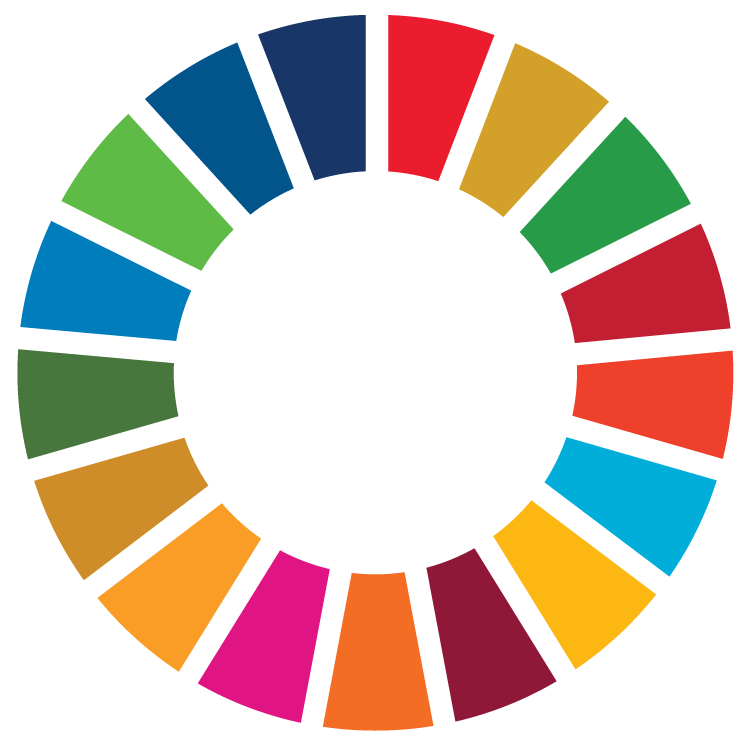Reporters: Mr. Sujinda Saehan, Mr. Ekkajak Intarat, Mr. Nitigon Jumniansuk, Mr. Thanet Sangseejun
Evidence Date: January – December 2024
Related SDGs: 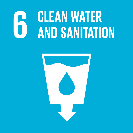
Related Indicators: 6.2.1, 6.2.2
Details:
Water consumption at Rajamangala University of Technology Srivijaya (RUTS) varies considerably depending on factors such as the local climate, campus infrastructure, facility types, and the number of students and staff. Understanding how and where water is used is essential for developing effective conservation strategies. In recent years, RUTS has made significant progress in water conservation, successfully reducing overall water consumption by nearly 12% through various management initiatives and technological improvements. The main areas of water use on campus typically include the following:
– Cafeteria and Dining Facilities: Campus dining halls and cafeterias are major consumers of water. Water is needed for cooking, food preparation, cleaning, and dishwashing. With a large number of students and staff served daily, these activities can lead to substantial water use. RUTS has introduced efficient dishwashing systems, carried out regular maintenance of kitchen equipment, and provided staff training on water-efficient practices to reduce unnecessary waste.
– Landscaping and Irrigation: The university maintains extensive outdoor areas, including gardens, lawns, and sports fields, which require significant irrigation—especially during Thailand’s dry and hot seasons. To address this, RUTS has adopted xeriscaping techniques (using drought-resistant plants), automatic irrigation systems, and rainwater harvesting to reduce reliance on tap water. The university also encourages the use of treated wastewater or greywater for landscape irrigation where feasible. These strategies have played a key role in lowering the university’s overall water demand.
– Faculty Buildings and Laboratories: Academic and research facilities consume water for a variety of purposes—scientific experiments, chemical reactions, equipment cooling, and sanitation. Laboratories, in particular, must maintain high cleanliness standards, leading to frequent washing of glassware and instruments. To manage this, RUTS promotes the use of closed-loop cooling systems, automated shut-off valves, and water recycling processes in laboratory operations, contributing to measurable reductions in daily water use.
– Athletic and Recreational Facilities: Sports complexes, gyms, and athletic fields also contribute to overall water use. Facilities require water for showers, cleaning, and maintaining sports grounds. Natural grass fields need regular watering, especially during summer months. The university has begun implementing smart irrigation controllers and soil moisture sensors to optimize watering schedules and minimize overuse—measures that have supported the university’s 12% reduction in consumption.
– Restrooms and Sanitation: Restrooms across campus represent a significant portion of total water consumption. Traditional toilets and taps can use large volumes of water. To reduce this, RUTS has installed low-flow fixtures, dual-flush toilets, automatic sensor taps, and leak detection systems. Regular maintenance checks are also conducted to prevent water loss from leaks or faulty plumbing. These upgrades have contributed directly to measurable decreases in total water usage.
– Water Conservation Initiatives and Education: RUTS has implemented several initiatives to promote water efficiency and awareness:
- Rainwater harvesting systems to collect and reuse rainwater for non-potable purposes such as cleaning and irrigation.
- Public awareness campaigns and signage encouraging students and staff to use water responsibly.
- Annual water audits to monitor usage and identify opportunities for improvement.
- Integration of sustainability and water management topics into academic programs, workshops, and student-led projects to build environmental stewardship.
These continuous efforts have helped foster a strong culture of sustainability across the university community.
– Policy and Long-Term Sustainability Efforts: In line with Thailand’s national sustainable development goals and the United Nations Sustainable Development Goal (SDG) 6: Clean Water and Sanitation, RUTS continues to strengthen its Water Management Policy. The university collaborates with local authorities, environmental agencies, and research institutions to develop innovative water-saving technologies and improve wastewater treatment efficiency. The commitment to sustainable water use has been instrumental in achieving the 12% reduction milestone and will guide future sustainability planning.
Through a combination of technological improvements, sustainable landscaping, awareness campaigns, and educational initiatives, Rajamangala University of Technology Srivijaya demonstrates its strong commitment to responsible water management. The university’s success in reducing total water consumption by nearly 12% reflects the effectiveness of its conservation policies and campus-wide participation. Continued investment in water-saving infrastructure and sustainability education will help ensure that RUTS’s water use remains efficient, environmentally friendly, and aligned with long-term sustainability goals.
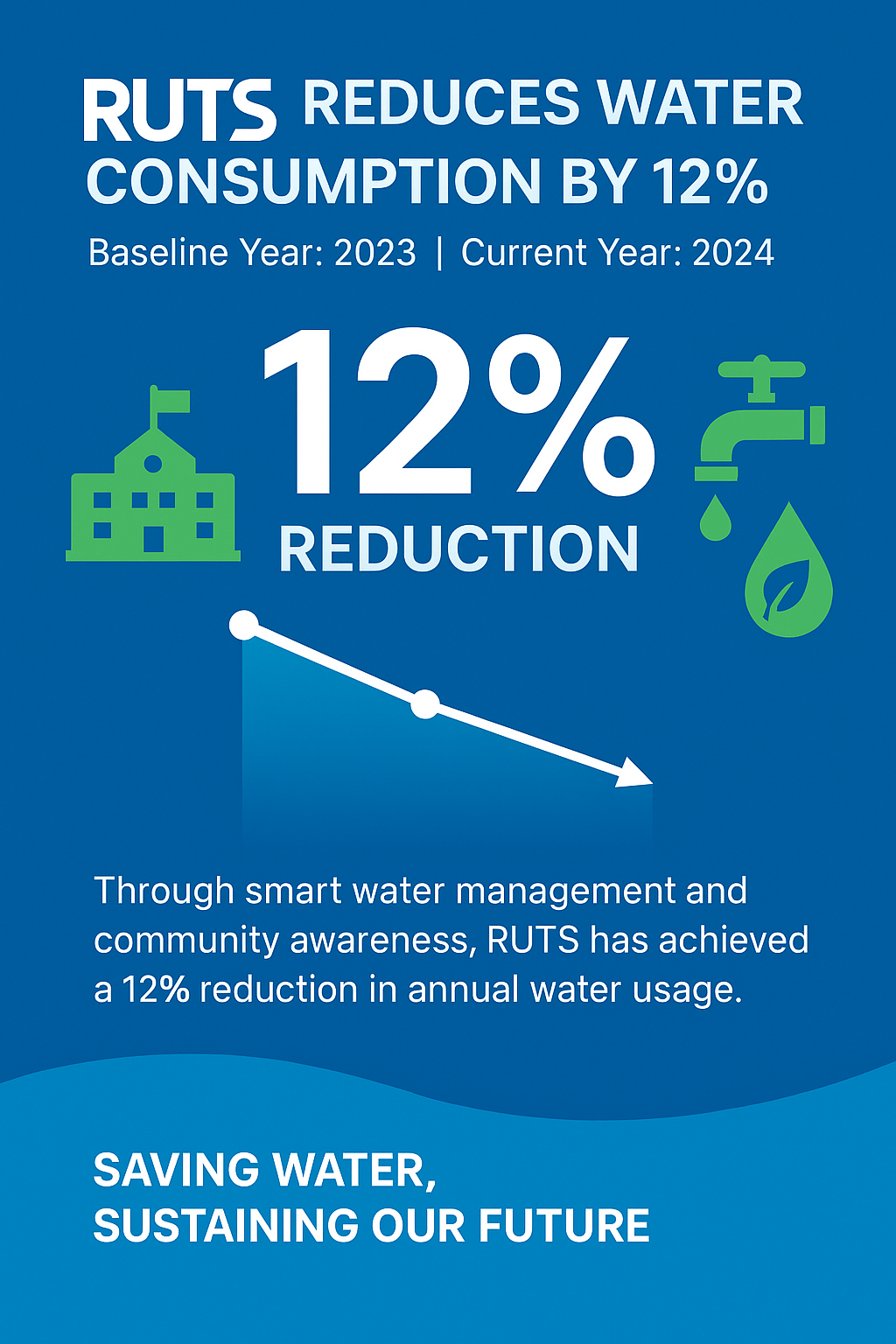
Annual Water Consumption at RUTS (2023–2024)
The figure presents the monthly water consumption levels at Rajamangala University of Technology Srivijaya (RUTS) for 2023 and 2024. The data indicate a 12% reduction in total water usage in 2024 compared to 2023.
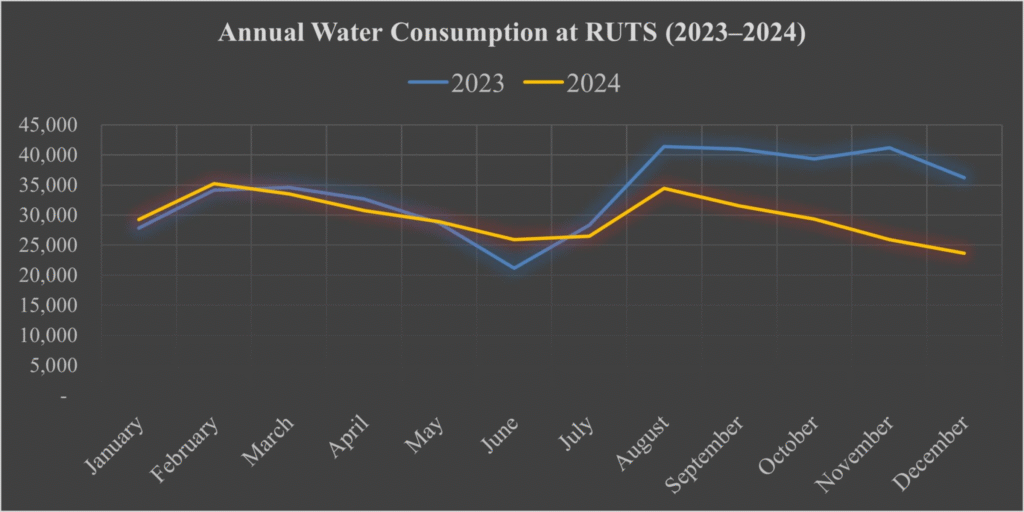
The line graph illustrates the monthly water consumption at Rajamangala University of Technology Srivijaya (RUTS) during 2023 and 2024. The vertical axis represents the amount of water consumed, ranging from 5,000 to 45,000 units, while the horizontal axis displays the months from January to December. The data reveal that water consumption in 2023 (blue line) was consistently higher than in 2024 (yellow line) throughout most of the year, indicating a notable overall reduction in water use over time.
In both years, consumption followed a similar seasonal pattern, beginning at relatively high levels in January, peaking around February, and declining steadily toward mid-year. The lowest point occurred in June for both years, after which consumption increased sharply during July and August. In 2023, usage reached a peak of nearly 45,000 units in August, while in 2024, the rise was more moderate, followed by a gradual decline from September to December.
A key observation is that RUTS successfully reduced its overall water consumption by approximately 12% in 2024 compared with 2023, reflecting a measurable improvement in water management and conservation practices. This reduction may be attributed to the implementation of sustainability initiatives, more efficient infrastructure, increased awareness campaigns, or reduced operational demand during certain periods.
In summary, while the seasonal pattern of water consumption remained consistent across the two years, the overall decline in 2024 demonstrates the university’s effective efforts to enhance water-use efficiency and align with environmental sustainability objectives.
Table of the use of water in the year 2024 from January to December
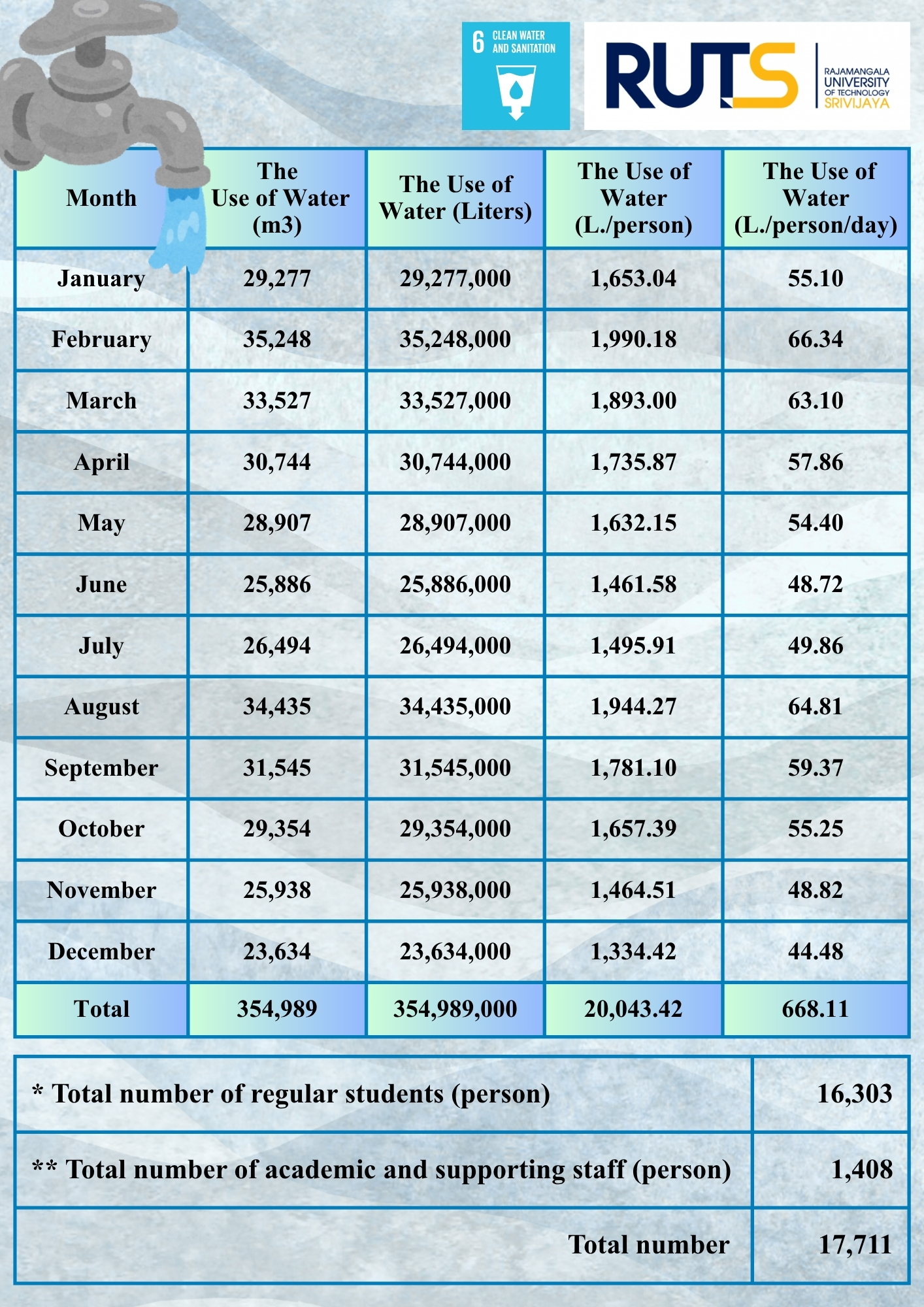
Water Consumption from Water Supply vs. Natural Water Source
within 5 Main Areas (m3) (January – December 2024)

The line graph illustrates the volume of water consumption (in cubic meters) derived from two primary sources, the municipal water supply system and natural water sources, across five main areas: Songkhla, Sai Yai, Thung Yai, Kanom, and Trang. The data reveal distinct patterns of water source dependency and reflect how each area’s water management practices align with local conditions and conservation policies.
In Songkhla, water consumption was entirely dependent on the municipal water supply, totaling 109,089 m³, with no recorded use of natural water sources. This suggests the presence of a well-developed water supply infrastructure and possibly the implementation of controlled distribution policies to promote efficient and reliable water use within urban and institutional settings.
Conversely, Sai Yai and Thung Yai relied exclusively on natural water sources, with recorded consumptions of 28,482 m³ and 113,390 m³, respectively. Notably, Thung Yai exhibited the highest overall water consumption among all areas. This trend may indicate an abundance of local natural water resources, yet it also highlights the importance of implementing sustainable water management strategies, such as regulating extraction and promoting water conservation awareness to ensure long-term resource stability.
In Kanom, the total water consumption from the supply system was 8,831 m³, among the lowest across all areas, with no utilization of natural water sources. This relatively low level of consumption could imply effective water-saving practices, possibly driven by institutional policies or community efforts to reduce water usage and optimize available supply.
Finally, Trang demonstrated complete reliance on natural water sources, using 95,197 m³. This reflects a similar pattern to Sai Yai and Thung Yai, where natural water resources serve as the primary supply for local needs. However, it also underscores the need for integrated resource management to prevent overuse during periods of drought or reduced rainfall.
Overall, the data reveal a clear spatial differentiation in water source utilization and management approaches. Songkhla and Kanom depend exclusively on municipal water supplies, supported by structured infrastructure and regulated use, whereas Sai Yai, Thung Yai, and Trang rely on natural water sources, requiring more adaptive and conservation-oriented management strategies. These variations emphasize the significance of localized water-saving policies and area-specific adaptation plans, which are essential for promoting sustainable water consumption, enhancing resilience to seasonal variations, and ensuring long-term environmental stewardship across diverse regional contexts.
Table of water consumption from water supply and natural water source
within 5 main areas (m3)

Related Links:
